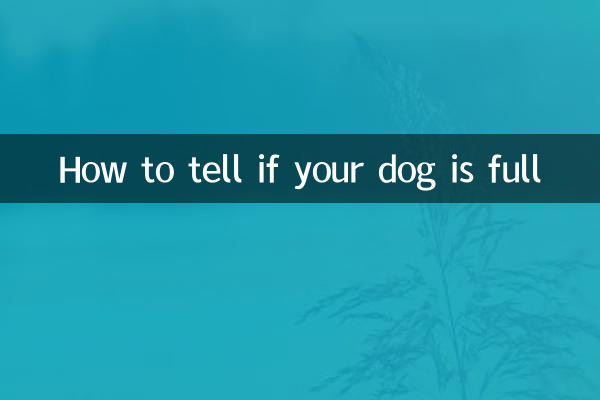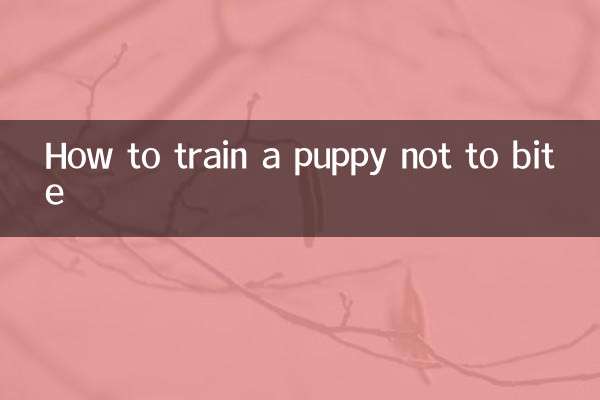Title: How to tell if your dog is full
As a pet owner, knowing if your dog is eating enough is an important part of ensuring their health. Dogs' dietary needs vary by breed, age, weight and activity level, so it's important to have a scientific approach to judgment. This article will combine the hot topics and hot content on the Internet in the past 10 days to provide you with structured data and analysis to help you accurately judge your dog’s dietary status.
1. Common signs that dogs are full

Dogs usually show the following behaviors or signs after eating. These signals can help owners make preliminary judgments:
| Performance | illustrate |
|---|---|
| stop eating | The dog voluntarily leaves the food bowl and no longer shows interest in food. |
| lick mouth | After eating, your dog may lick his mouth to show satisfaction. |
| Relaxed posture | The body is stretched, perhaps lying down or resting quietly. |
| Say no to snacks | I am also indifferent to my usual favorite snacks. |
2. Scientific method to determine whether your dog is full
In addition to observing behavioral performance, you can also judge your dog’s eating status through the following scientific methods:
| method | Specific operations |
|---|---|
| touch ribs | Gently touch the dog's ribs with your hands. If you can easily feel it but cannot see it, it means the weight is moderate; if you can't feel it, you may be overweight. |
| Observe the waistline | Viewed from above, the dog's waist should have a clear curve; viewed from the side, the abdomen should be drawn in. |
| Calculate calories | Calculate the daily caloric requirements based on the dog's weight and activity level, and distribute meals reasonably. |
| Weigh regularly | Weigh yourself once a week to make sure your weight remains within a healthy range. |
3. Dietary needs of dogs of different ages
The dietary needs of dogs change greatly with age. The following are the dietary characteristics of each stage:
| age group | Diet characteristics | Feeding frequency |
|---|---|---|
| Puppies (0-1 years old) | High protein, high calorie, small and frequent meals. | 3-4 times a day |
| Adult dogs (1-7 years old) | Balanced nutrition and weight maintenance. | 2 times a day |
| Senior dogs (over 7 years old) | Low in calories, easy to digest, and supplements joint nutrition. | 2-3 times a day |
4. Hot topics about dog diet in the past 10 days on the Internet
The following are the topics related to dog diet that have been hotly discussed on the Internet recently for your reference:
| topic | heat index | Main content |
|---|---|---|
| What to do if your dog is picky about food | ★★★★★ | Discuss how to correct your dog’s picky eating behavior and recommend palatable food. |
| The pros and cons of feeding raw meat and bones | ★★★★☆ | Analyze the advantages and potential risks of feeding raw meat and bones. |
| The dangers of dog obesity | ★★★★☆ | Remind owners to pay attention to their dogs’ weight and share weight loss methods. |
| Homemade Dog Food Recipe | ★★★☆☆ | Share healthy and economical homemade dog food recipes. |
5. How to adjust your dog’s diet plan
If you find that your dog often doesn’t eat enough or overeats, you can take the following measures:
1.Consult a veterinarian: Rule out disease factors and get professional advice.
2.Choose high-quality dog food: Ensure that the dog food is nutritionally balanced and meets the needs of the dog.
3.fixed feeding time: Establish regular eating habits and avoid random feeding.
4.Increase exercise: Regulate appetite and promote metabolism through exercise.
5.Monitor weight changes: Record your weight regularly and adjust your food intake in a timely manner.
6. Summary
Determining whether your dog is full requires a combination of behavioral observations and scientific methods. Owners should pay attention to the dog's daily performance, regularly check the weight and size, and adjust the diet plan according to age and activity level. The recent hot topic of dog diet on the Internet also reminds us that scientific feeding is the key to ensuring the health of pets. If you have any questions about your dog's dietary status, it is recommended to consult a professional veterinarian promptly.

check the details

check the details